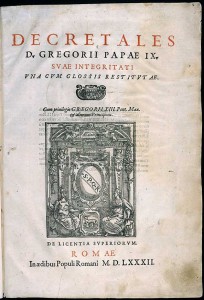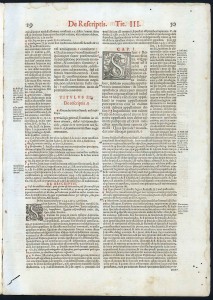Corpus Juris Canonici
 In 1582, the same year that Pope Gregory XIII introduced his revised calendar to the world, the pontiff saw the culmination of another of his scholarly projects, a revised edition of the Corpus Juris Canonici, the “Body of Canon Law.” The three large volumes contained not only the medieval collections laws — notably, Gratian’s Decretum, Gregory IX’s Liber Extra, and Boniface VIII’s Liber Sextus — but also the elaborate Ordinary Glosses and further commentaries on the laws that took up the vast inner margins, with further up-to-date annotations on outer margins. These glosses, which are absolutely essential to historians of law, have not been reprinted since the seventeenth century, and copies are scarce and invariably stowed away in Special Collections, making steady and hands-on usage very difficult.
In 1582, the same year that Pope Gregory XIII introduced his revised calendar to the world, the pontiff saw the culmination of another of his scholarly projects, a revised edition of the Corpus Juris Canonici, the “Body of Canon Law.” The three large volumes contained not only the medieval collections laws — notably, Gratian’s Decretum, Gregory IX’s Liber Extra, and Boniface VIII’s Liber Sextus — but also the elaborate Ordinary Glosses and further commentaries on the laws that took up the vast inner margins, with further up-to-date annotations on outer margins. These glosses, which are absolutely essential to historians of law, have not been reprinted since the seventeenth century, and copies are scarce and invariably stowed away in Special Collections, making steady and hands-on usage very difficult.
UCLA ’s Charles E. Young Research Library is fortunate to have a complete set of the 1582 Corpus, and the Library, with the support of CMRS, has undertaken to digitize the whole set and make it available online. The work was begun under the direction of Howard Batchelor, UCLA Digital Library Coordinator, with the guidance of UCLA’s resident canonist, Professor Andy Kelly (English), a former Director of CMRS and the current Editor of our journal Viator. The work is being carried on by Stephen Davison, Head of the UCLA Digital Library Program. A generous grant for the project has been secured from the Gladys Krieble Delmas Foundation through the intercession of Gary Strong, UCLA Librarian. CMRS has also provided funding for the project.
The complete text of all three volumes of the Corpus Juris Canonici is online at the UCLA Library Digital Collections site. This means scholars who are already experts in canon law are able to access these texts from the comfort of their own offices.
 But what about those scholars who do not know their way around in the laws of the Church? How are they to find out what laws are pertinent to a particular subject that they are research? The Ordinary Glosses have an elaborate system of cross-references once you get to where you want to go. But how to get there in the first place? One way is to use the elaborate subject indices at the front and back of each volume.
But what about those scholars who do not know their way around in the laws of the Church? How are they to find out what laws are pertinent to a particular subject that they are research? The Ordinary Glosses have an elaborate system of cross-references once you get to where you want to go. But how to get there in the first place? One way is to use the elaborate subject indices at the front and back of each volume.
These indices can be used without further ado, just as they exist in the volumes (though there are many errors in column numbers cited). But to make things easier, graduate students in medieval and Renaissance fields, transcribed and edited the indices and made them searchable.
Professor Kelly decided to start work on the indices of the Liber Extra which is the most important of three volumes from the standpoint of official law. Students working on the project were Tom O’Donnell, Jennifer A.T. Smith, and Alison Walker, all of the English Department, and Maria Kritikou and Sherrylyn Branshaw of the Indo-European Studies Program.

